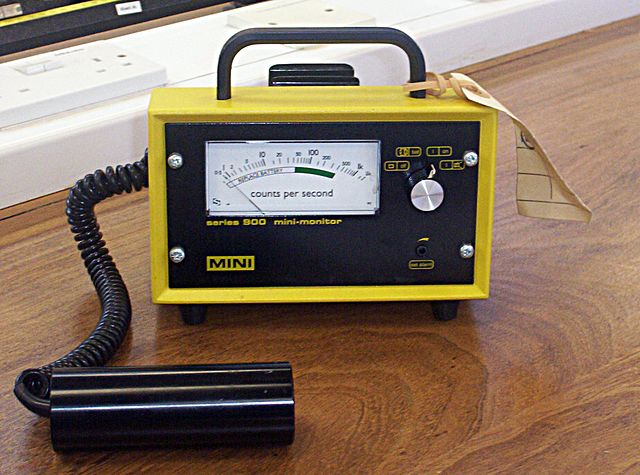
How does a Geiger counter work? By using radiation to create an electrical signal.
There are four types of radiation and they all have different mass and energy. The types are alpha, beta, neutrons, and electromagnetic waves.
Alpha particles are the heaviest. They have two protons and two neutrons. They are made by many of the naturally occurring radioactive materials on Earth, such as uranium. They are heavy and slow, so they are stopped by most materials. They cannot pass through a piece of paper. They have enough energy to shake atoms, but not enough energy to ionize them. “Ionize” means to strip electrons off the atom.
Beta particles have a small mass and a negative charge. They have a lot of energy and speed. They are created by the radioactive decay of an atomic nucleus. They can penetrate more deeply than alpha particles and are more dangerous because of their ionizing power. They can be stopped by a few millimeters of aluminium or the clothes you are wearing. Beta radiation can be harmful if exposed for too long. It is one of the radiations used in radiation therapy for cancer.
Neutrons are released when uranium atoms split. They don’t have any charge. They are very powerful and are also ionizing radiation. It takes almost a meter of concrete to stop neutrons.
Electromagnetic radiation is a whole range of radiation that goes from very long wavelengths without much energy, such as extremely low frequency radio waves. They are not harmful and will pass through the human body with no problem. At the other end of the spectrum, x-rays and gamma rays have a lot of energy and are powerfully ionizing radiation.
We obviously cannot detect that there are high levels of radiation, and we won’t know until we get very sick a while later. Radiation is measured in millisieverts (mSv) and a lethal does of radiation is about 4000 mSv delivered over a short time. It kills the stem cells in the bone marrow and most people exposed to an amount of radiation this high or higher will die within a month or so. With medical treatment, they might be able to last a little longer. The highest known radiation dose anyone has ever received was a worker at the Tokaimura nuclear plant in Japan. In 1999, he was exposed to 17,000 mSv.
So, how does a Geiger counter work? It works by using the radiation’s ability to ionize to detect it. Inside the Geiger counter is a chamber holding a noble gas. A noble gas is a very unreactive gas, such as helium and neon. They are often called inert gases because of this lack of reaction. They are very stable and don’t form chemical bonds.
The Geiger counter chamber has a wire down the middle that serves as the anode and the walls are lined with a material that serves as the cathode. The anode is negatively charged and the cathode is positively charged from an electrical source, usually a battery. The gas in the chamber is inert, so it doesn’t conduct an electrical charge and there is no connection between the anode and the cathode. Noble gases cannot have an extra electron without losing an electron, so nothing happens.
When ionizing radiation enters the tube, it knocks electrons off the noble gas atoms. This creates free electrons and ion pairs. An ion pair is the remaining electron and the atom, which become negatively charged. The loose electrons fly towards the negatively charged anode and the ion pairs fly towards the positively charged cathode where they pick up another electron to replace the missing one. This creates an electric current. The strength of the current is proportional to the strength of the radiation. The Geiger counter will usually have a readout that displays number of ions per minute. They also usually have a speaker that clicks every time an ion pair is made. The more clicks there are, the more radiation there is. More expensive Geiger counters can convert the number of ions pairs made into a mSv figure, but this is incredibly complex.
Geiger counters are very useful, but they cannot tell the difference between different types of radiation. They can also get overwhelmed if there is too much radiation. And this is what I learned today.
Sources
https://www.sciencedirect.com/topics/earth-and-planetary-sciences/alpha-radiation
https://en.wikipedia.org/wiki/Beta_particle
https://en.wikipedia.org/wiki/Geiger_counter
https://www.livescience.com/how-a-geiger-counter-works.html
https://www.nrc.gov/reading-rm/basic-ref/students/science-101/what-is-a-geiger-counter.html
https://www.co.monmouth.nj.us/documents/118/RADIATION%20HEALTH%20BASICS.pdf
https://en.wikipedia.org/wiki/Electromagnetic_spectrum
